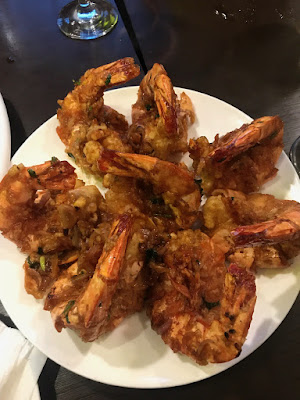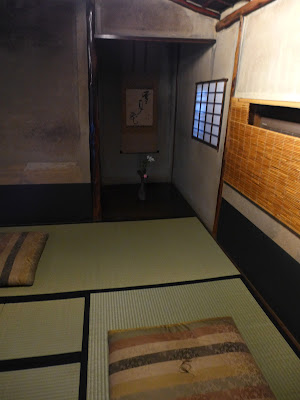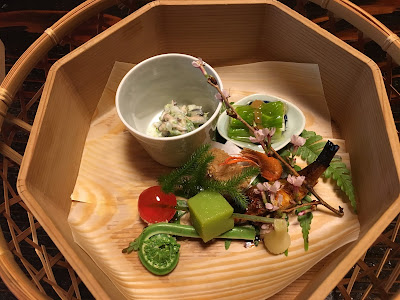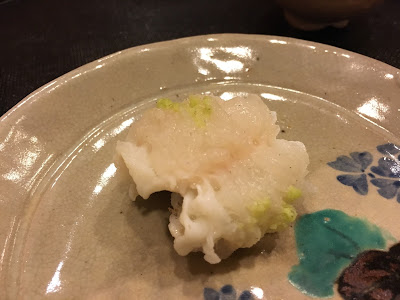Kyoto in spring, if one is lucky enough to time it right to be there just when the cherry blossoms bloom, is a spectacularly beautiful scene. In the Kyoto area, particularly, about 130 varieties of cherry blossoms bloom over a very short period of time. So, the visual effects are quite spectacular.
Everyone from all over Japan, and elsewhere make a pilgrimage to where the blossoms are in bloom. Many Japanese, by tradition, follow those blossoms as they bloom, from region to region in Japan.
It is essential to book airline and hotel reservations about a year ahead to ensure getting a good room and a good airline seat. The same applies to getting reservations at the most interesting restos. Having a very good Japanese friend may help, or, write directly to your hotel concierge as early as you can. In making your booking, you are playing a bit of a roulette game, hoping your timing will be just right. Among my several trips to Japan, I have only managed to time it right, twice.
Hyotei
This sublime, peaceful, beautiful path leads through the interior of Hyotei restaurant, originally founded as a tea house in the 17th century and converted to a full fledged restaurant in 1837. This striking path led us into a resto owned by the same family for 16 generations and having a 15th generation chef. They have a 400 year old tatami mat covered room for special meals. We enjoyed our meal in our own 200 year old tatami mat covered room.
The men's washroom has urinals filled with spruce and pine boughs and also has a woven grass and bamboo hand washing bowl filled with water and a long bamboo stem handle with an attached bamboo cup, rests on the bowl and is there to be filled with the water and used for washing and rinsing one's hands.
The continuing path leading to our private room.
Our tatami mat covered, 200 year old private room. Our lovely and very knowledgeable host, Kumi, sitting at table in front of the tokonoma, a recessed space where honoured items for artistic appreciation are displayed.
Our personal hostess who served us our meal. This is a formal kaiseki (analogous to western haute cuisine) presentation.
The bold faced introductions below present the formal stages of the meal.
Sakizuke (Appetizer)
Simmered broad beans with young sansho leaves (no photo).
Mukozuke (Sliced Seasonal Sashimi)
Tai (red sea bream) sashimi from Akashi (where the best sea bream is fished) with basic soy sauce and new style soy sauce made with tomato.
Close up of the above.
Nimono-wan (Simmered Dish)
Greenling with kudzu starch, butterbur, udo plant and leaf bud accompanied by daikon radish shaped into a cherry blossom.
Hassun (Second Course)
Presentation.
Hyotei tamago ( their version of soft boiled egg). This is the traditional cooked egg that Hyotei first offered to travelers who approached the Nanzenji temple about 400 years ago. It was considered a rare and luxurious find. The egg has been continually offered since the restaurant's founding. It is presented with fried ice fish with rice powder, bamboo shoot coated with basil miso sauce, rapeseed blossoms rolled in trout with egg yolk vinegar sauce, caviar and fried fatsia (aralia) sprout with rice powder. Also present is a lily bulb shaped to look like the seasonal cherry blossom petals.
Abramono
Tempura of bamboo shoots with prawn; tempura of seasonal onion; simmered ostrich fern; dashi-soy sauce with grated daikon.
Shiizakana
Prawn, cockle, udo plant, cucumber and tomato with milt (fish semen) sauce, topped with red taro jelly.
Yakimono (Flame Grilled Food)
Charcoal grilled tile fish; wasabe leaves; special sauce with a citrus flavour.
Gohanmono (Rice Dish with Seasonal Ingredients)
Red miso soup; tofu with Japanese parsley and bracken; rice with scallop and bamboo shoots; roast beed (Tosa-Akaushi beef....The Tosa red cow is a rare variety of brown-colored cattle, accounting for only 0.1% of all “wagyu” beef cattle in Japan. Its key feature is the deliciousness of its meat. Raised in Koji prefecture, Shikoku Island)
Konomono (Pickles) (no photo).
Mizumono (Seasonal Fruits)
Green tea ice cream made with egg (no milk), and lemon oil accompanied by a strawberry and melon.
Usu-cha (Green Tea Service)
A serving of roasted green tea followed.
Omogashi (Moist Sweet)
Wasabi mochi.
The 400 year old tatami mat covered room.
The height of the room is intentionally low to make anyone with any height be slightly bent-kneed.
Iida
The entrance tokonoma.
The Tokonoma (alcove of honour in the background).
Fried scallop and simmered bracken and aralia sprout; urui (a foraged vegetable) and udo marinated with soy bean paste with wasabe flower and pickled wasabe. All accompanied by soy sauce and arrowroot with vinegar.
Soup: greenling, half dried sea cucumber ovary, Japanese ginger and sansho leaves.
The soup cup itself is "Makie" with a cherry blossom design, reflective of the season and maple leaves which symbolize eternity.
Sashimi of snapper from Akashi (the best area) topped with milt (semen), accompanied by mustard flower.
Sashimi of squid and sea urchin with Taiza nori and soy sauce.
Steamed broad beans with mullet roe.
Boiled bamboo shoots.
Presentation of the dish below.
Grilled soy bean curd with ginger soy bean paste (called tofu dengaku).
Grilled bamboo shoots with thin sliced dried bonito with sansho leaves.
The presentation of the dish below.
Tempura of cherry shrimp.
Mozuku seaweed and thin sliced yam (no photo).
Dried flowering fern rolled in soy bean curd skin with giant butterbur and white asparagus. It is extremely rare to be served dried flowering fern (in skin) as it takes an inordinate amount of time to soften in order to be used. There are extremely few chefs who do this and the number of craftsmen who know the proper technique to dry them has been steadily decreasing.
Presentation of dish below.
Miso soup with wakame seaweed; pickles: dried daikon, cabbage, dried plum and shiso.
Rice with trout, bamboo shoots and sansho nuts.
How everything is enjoyed together.
The interior to the top of the miso soup.
Strawberry with blanc mange of roasted green tea and blood orange.
The cup which contained my green tea during service.
Cherry mochi with red bean paste inside.
Matcha green tea served at the conclusion of service (fyi, a serving of matcha powdered green tea has 137 times more antioxidants than regularly brewed green tea and about 20 times more than a serving of blueberries).
SAKE: TEDORIGAWA AND KOKURYU RYU.
MIYAMASOU
Miyamasou is one of the most famed Ryokans in Japan, known for its Tsumigusa cuisine (freshly picked in Japanese). At Miyasansou, only fresh seasonal ingredients found locally such as wild mountain vegetables and herbs, fish from the streams in the mountain, and fresh fish from the sea, are used. I have been coming to Miyamaso since 1988!! Miyamasou was originally a lodging in front of the Bujouji Temple. It located in the mountains about an Hour north of Kyoto.
Our saki carafe and my cup.
Presentation. The chopsticks were fashioned by the chef from fresh bamboo branches.
Hassun (Appetizer)
Giant butterbar mixed with soy bean curd paste siitake (emperor's shiitake); Fried konnyaku with pounded horse chestnut; urui with plum jelly; gudgeon (fish from lake Biwa); fried river shrimp; nobiro (a leek like veg); ostrich fern.
Presentation.
Carp sashimi with fried carp skin, bracken marinaded in kobu seaweed and ground daikon and nobiru.
White soy bean soup with fava beans and arrowroot.
Wild yam with vinegar and dashi.
Tempura: dandelion leaf, suiba leaf, ascetic garlic leaf, aralia sprout, ostrich fern, koshiabura (leaf in the aralia family) and azalea flower.
Charred and grilled whole bamboo shoot.
Boar confit with wild stone parsley, butterbar sprout and shiitake.
Presentation.
Steamed sushi with ostrich fern, knotweed, flowering fern, baby ayu, sliced soy bean skin and the reproductive shoot of field horse tail.
Presentation.
Tile fish with turnip, udo, dandelion leaf, wasabi flower, all in a clear soup.
Presentation.
Grilled trout with natsumikan accompanied by orange and vinegar.
The grilled trout plated.
The orange vinegar.
Simmered mustard flower and quail dumpling.
Rice with trout and Japanese parsley.
The rice plated.
Pickles: turnip, mustard flower and dried daikon.
Milk from Miyama, jelly with Hassaku orange marmelade, wild carrot leaf and gojiberry.
Mugwort mochi.
Traditionally prepared matcha tea.
Sake: YOAKEMAE (from Nagano Prefecture).
Maeda
No photos were allowed at Maeda
Maeda kaiseki restaurant is very highly rated on tablelog and has 2 Michelin stars.
Clam and sea urchin with new nori seaweed with arrowroot.
Baby ayu (sweetfish) with sansyo salt and lemon.
Akagai (ark shell) and white asparagus with vinegar and soy bean and pine nuts with fried shiso leaf.
Mugwort custard with chopped bracken, wasabi and umadashi (strong dashi).
Soup: bamboo shoots, geoduck, wakame seaweed and half dried ovary of sea cucumber.
Sashimi: snapper marinated with kobu seaweed; dip in simmered sake with plum pickles; wet nori seaweed and soft skin of bamboo shoots, snapper roe and mustard flower.
Bamboo shoot with sansho leaf paste; egg soy bean paste and sansho leaves.
Ocellated octopus with giant butterbur and egg yolk vinegar.
Sea eel roll with spicy simmered butterbur sprout and sansho flower.
Blue crab with ostrich fern and sesame paste, bracken and wasabi vinegar and wasabi stalk.
Snapper roe, tilefish, fried yam, soy bean curd skin, butterbur sprout and shiitake mushroom.
Pickles: daikon, kobu seaweed, Chinese cabbage and wild mustard.
Dessert: 3 kinds of orange: amanatsu; kiyomi; dekomomoe accomapnied by strawberry.
SAKE: KAKEYA (SHEMANE PREF); KUROKIJYOZU (YAMANGATA PREF); KAZE NO MORI (NARA PREF).
SUZUE
Suzue is a very highly rated kaiseki restaurant on Tabelog, ranking #1 in Kyoto and has 2 Michelin stars. The dishes used for presentation are great old collectors items and are museum quality.
Sake carafe and cup presentation.
On left: half beak, hari squid, prawn, firefly squid dressed with olive oil (made domestically on Shodo Island, first pressing). On right: aralia sprout, asparagus, ostrich fern bracken and peas with olive oil.
Presentation of red sea urchin from Awaji Island, with yuzuri leaf and wasabi. ***plate is Ming Dynasty (!!!!!).
The full presentation of the above.
Cherry blossom colours snapper sashimi is added to the plate.
Presentation.
Greenling presented in the soup cup above, call Nichigetsu Wan, which means sun and moon.
Grilled sea eel from Awaji island.
One of the great antique ceramics used for presentation.
The grilled sea eel, plated.
Bamboo shoots, tile fish and ground daikon in soup.
Presentation of a great very old sake carafe.
Sushi: ark shell (akagai) with mustard flower and tuna (never frozen!!!) from Wakayama prefecture.
The presentation of another antique ceramic plate. This plate the sushi is presented on below is a registered Ming Dynasty plate called Gosushiro.
The ark shell and mustard flower sushi.
The tuna sushi.
Strawberry mochi made using momo-ichigo (peach and strawberry, giving the mochi a peach aroma).
Another great antique plate used for presentations to other clients.
Another great antique plate used for presentations to other clients.
Another great antique plate used for presentations to other clients.
SOUKOO SAKE FROM FUSHIMA, KYOTO.
Our view at breakfast.
Presentation.
Bonito dashi in a small cup (no photo).
Lotus, bread-like food made of wheat gluten, Japanese parsley, shiitake marinated with sesame paste.
Sweet fried udo.
Ice fish (note the black dots, their eyes).
Plum and daikon pickles.
Natto.
Simmered hijiki salad with plum.
Vegetables: red daikon, broccoli, broad beans, onion accompanied by olive oil, salt and soy bean paste (see below).
Raw eggs (to be eaten raw).
Lunch that the resto packed for us. Look how elaborate the wrapping is.
The wrapping removed.
Our wonderful box lunch.












































































































































